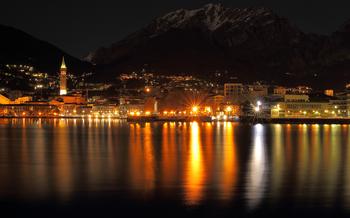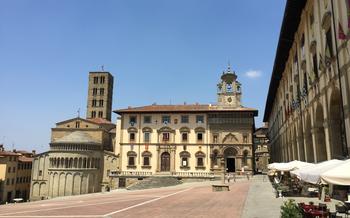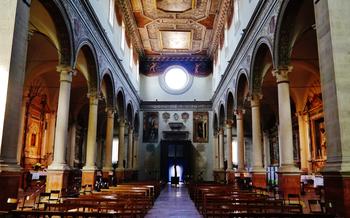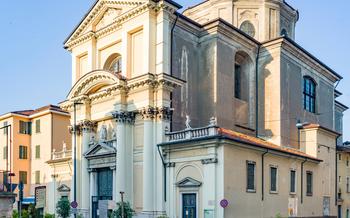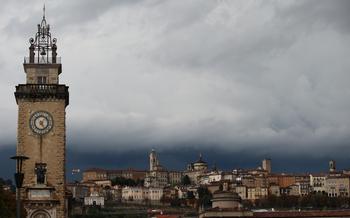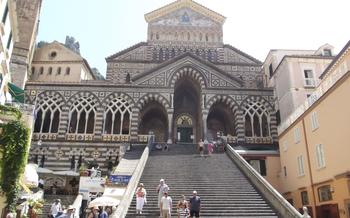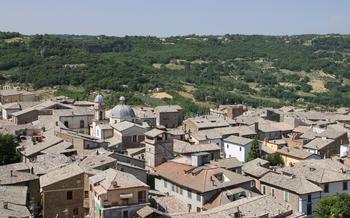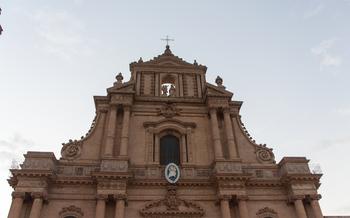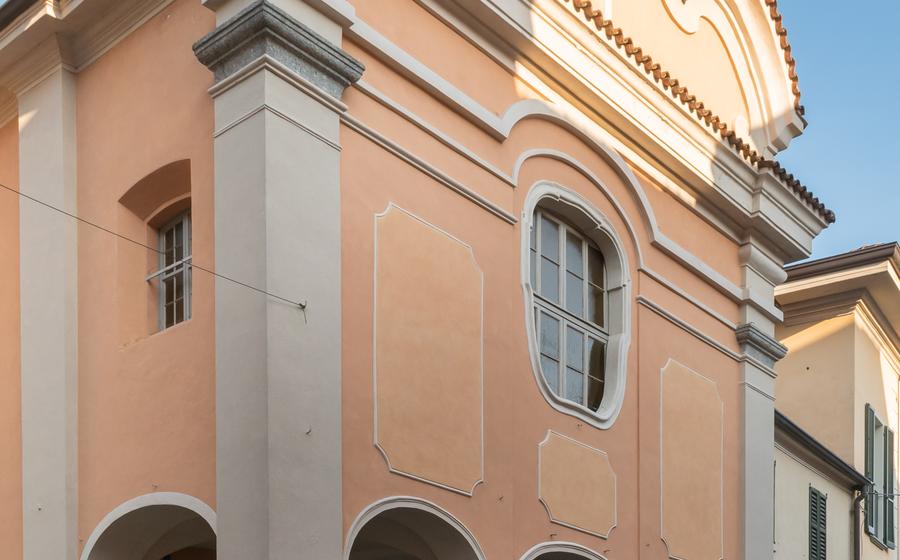
Church of Santa Marta
- History of the Church of Santa Marta
- Architecture of the Church of Santa Marta
- The Frescoes of the Church of Santa Marta
- The Altarpiece of the Church of Santa Marta
- The Stained Glass Windows of the Church of Santa Marta
- The Organ of the Church of Santa Marta
- The Crypt of the Church of Santa Marta
- The Bell Tower of the Church of Santa Marta
- Visiting Tips for the Church of Santa Marta
- Admission Fees and Reservations for the Church of Santa Marta
- Events and Festivals at the Church of Santa Marta
- Insider Tip: Unraveling the Secret of the Lost Fresco
History of the Church of Santa Marta
The origins of the Church of Santa Marta in Lecco can be traced back to the late 15th century when Lecco was under the rule of the Duchy of Milan. The construction of the church was initiated in 1490 and completed around 1500. The church was built in the Lombard Gothic style, which was prevalent in the region during that period.
Originally, the Church of Santa Marta was a small chapel dedicated to Saint Martha, who is revered as the patron saint of housewives and hospitality. Over time, the chapel was enlarged and embellished, reflecting the growing devotion to Saint Martha and the importance of the church in the religious life of the community. The church underwent several renovations and expansions in the 17th and 18th centuries, resulting in the addition of side chapels, a sacristy, and a bell tower.
Architecture of the Church of Santa Marta
The Church of Santa Marta is an architectural marvel that showcases a blend of Romanesque and Gothic elements, creating a unique and visually appealing structure. Its exterior boasts an elegant facade adorned with intricate carvings and sculptures, portraying biblical scenes and figures. The bell tower, a prominent feature of the church, stands tall and majestic, adding to the overall grandeur of the building.
Stepping inside the church, visitors are greeted by a spacious and awe-inspiring interior. The layout follows a traditional basilica plan, with a central nave flanked by two side aisles. The nave is supported by rows of slender columns, creating an impression of height and spaciousness. The ceiling features a ribbed vault adorned with intricate frescoes, adding another layer of artistic beauty to the interior.
Notable features of the church include the pulpit, crafted from finely carved wood and showcasing intricate detailing. The altar, positioned at the far end of the nave, is a masterpiece of craftsmanship, adorned with sculptures, carvings, and precious stones. The side chapels, each dedicated to a different saint, feature unique artwork and decorations, adding to the overall richness of the interior.
The Frescoes of the Church of Santa Marta
The interior of the Church of Santa Marta is adorned with stunning frescoes that date back to the 15th and 16th centuries. These frescoes, executed in the Late Gothic style, depict a variety of religious scenes and themes, including the life of Jesus Christ, the Virgin Mary, and various saints. The vibrant colors and intricate details of these frescoes create a sense of awe and devotion within the church.
One of the most notable frescoes is the "Annunciation," which portrays the angel Gabriel appearing to Mary to announce the birth of Jesus. This fresco is located in the apse of the church and is a masterpiece of the Renaissance period. Another highlight is the "Crucifixion," which depicts the suffering of Jesus on the cross. The expressions of pain and anguish on the faces of Jesus and Mary are particularly moving.
The frescoes of the Church of Santa Marta are not only beautiful works of art but also valuable historical documents. They provide a glimpse into the religious beliefs and practices of the people of Lecco during the Middle Ages and Renaissance periods. These frescoes are a testament to the enduring power of art and faith and continue to inspire visitors to this day.
The Altarpiece of the Church of Santa Marta
The altarpiece of the Church of Santa Marta is a striking and elaborate masterpiece, commanding attention with its intricate carvings and radiant colors. Crafted from the finest Carrara marble, the altarpiece depicts a celestial scene that captures the essence of the church's devotion. At its center, the Madonna and Child are enthroned, radiating divine grace and compassion. Accompanying them are a host of saints and angels, each rendered with exquisite detail and lifelike expressions.
The iconography of the altarpiece is rich in symbolism, reflecting the theological beliefs and aspirations of the community. The Madonna, a symbol of purity and maternal love, is depicted with the infant Jesus in her arms, representing the divine union of God and humanity. The surrounding saints, including Saint Peter, Saint John, and Saint Catherine, represent the pillars of the Church and serve as celestial intercessors. Angels, with their ethereal presence, symbolize the divine messengers and protectors.
The altarpiece is not merely a decorative element; it serves as a focal point for prayer and contemplation. Believers gather before it to offer their supplications and seek divine guidance. The vibrant colors and intricate details draw the eye, inviting the faithful to immerse themselves in the sacred narrative depicted in the artwork. The altarpiece stands as a testament to the artistry and devotion that have shaped the spiritual heritage of Lecco.
The Stained Glass Windows of the Church of Santa Marta
The Church of Santa Marta in Lecco boasts a collection of remarkable stained glass windows that adorn its interior, casting a radiant glow throughout the sacred space. These exquisite windows, crafted with intricate detail and vibrant colors, are a testament to the artistry and devotion of the church's builders.
The stained glass windows depict a variety of biblical and historical scenes, narrating stories from the Old and New Testaments, as well as significant events from the life of Saint Marta, the church's patron saint. The windows serve as a visual testament to the rich history and enduring faith of the Lecco community.
Each window is a masterpiece in its own right, featuring a unique color palette and intricate designs. The luminous hues of blue, red, green, and gold dance upon the walls, creating a mesmerizing spectacle that captivates the beholder. The skillful use of light and shadow adds depth and dimension to the scenes, bringing them to life before the viewer's eyes.
The stained glass windows not only enhance the beauty of the church's interior but also serve as a source of inspiration and contemplation for visitors. They invite the faithful to reflect on the stories depicted, to connect with the divine, and to find solace and guidance in their spiritual journey.
The Organ of the Church of Santa Marta
The grand organ of the Church of Santa Marta is a majestic instrument that has resonated within the sacred space for centuries. Its origins can be traced back to the 16th century, meticulously crafted by renowned organ builders of the era. The organ boasts an intricate design, showcasing a blend of artistic and engineering prowess. Its facade gleams with intricate carvings, while its pipes, arranged in an array of sizes, stand as silent witnesses to the musical masterpieces they produce.
The specifications of the organ are impressive, featuring multiple manuals and a comprehensive range of stops. Its keyboards allow the organist to produce a vast array of sounds, from delicate whispers to thunderous crescendos. The instrument's tonal palette encompasses a wide spectrum of colors, capable of evoking emotions from tranquility to jubilation.
Beyond its historical and aesthetic significance, the organ holds immense cultural and musical value. Throughout the centuries, it has been an integral part of religious services and musical performances within the church. Its melodies have accompanied countless weddings, baptisms, and other momentous occasions, weaving a tapestry of sound into the fabric of Lecco's history.
The organ at the Church of Santa Marta stands as a testament to the enduring power of music and its ability to elevate the human spirit. Its presence within the sacred space invites visitors to experience the divine through the language of sound, leaving an imprint on their souls that lingers long after they depart.
The Crypt of the Church of Santa Marta
The crypt of the Church of Santa Marta is a subterranean chamber beneath the main church building, offering a glimpse into the past and preserving valuable artifacts. Constructed during the 11th century, the crypt served as a sacred burial ground for notable religious figures and benefactors of the church. Its existence is of significant historical importance, as it sheds light on the early Christian traditions and practices in Lecco.
The crypt is characterized by its simple yet evocative architecture, featuring a series of stone-carved arches and barrel vaults. Its walls are adorned with faded frescoes depicting biblical scenes and narratives, adding an ethereal ambiance to the space. Visitors can observe the intricate details of the artwork, revealing stories of faith and devotion that have stood the test of time.
Archaeological excavations in the crypt have uncovered several tombs and burial chambers, containing the remains of priests, monks, and other individuals connected to the church. These discoveries have provided insights into the social and religious life of Lecco during the medieval period. Artifacts such as pottery, jewelry, and coins have also been unearthed, offering valuable clues about the economic and cultural practices of the time.
The crypt of the Church of Santa Marta stands as a testament to the rich history of the church and the community it serves. With its unique atmosphere and historical treasures, the crypt offers visitors a chance to delve deeper into the spiritual and cultural heritage of Lecco.
The Bell Tower of the Church of Santa Marta
Rising majestically over the historic center of Lecco, the bell tower of the Church of Santa Marta is an architectural masterpiece that has become an iconic symbol of the city. With a height of approximately 50 meters, it stands as a testament to the skill and artistry of the medieval builders who constructed it.
The bell tower's impressive structure boasts a blend of Romanesque and Gothic architectural styles, reflecting the transition that occurred during its construction period. The lower section exhibits sturdy Romanesque features, characterized by its thick walls and narrow arched windows. As the tower ascends, it transitions into a more delicate Gothic style, showcasing intricate carvings and elegant pointed arches.
The design of the bell tower includes four distinct levels, each marked by decorative cornices and moldings. The uppermost level features a series of arched openings, which house the bells that chime melodiously throughout the town. These bells, cast by renowned bell founders, produce a harmonious sound that resonates across the surrounding cityscape.
From the top of the bell tower, visitors are rewarded with breathtaking panoramic views of Lecco and its picturesque surroundings. The shimmering waters of Lake Como stretch out to the horizon, framed by the lush greenery of the Prealpine hills. On clear days, one can even catch glimpses of the distant snow-capped peaks of the Alps.
Visiting Tips for the Church of Santa Marta
To fully appreciate the beauty and history of the Church of Santa Marta, plan your visit during the morning or late afternoon when the natural light illuminates the interior in a magical way. Remember to dress respectfully, covering your shoulders and knees, and maintain a quiet and reverent atmosphere while inside the church.
For visitors with disabilities, the church is wheelchair accessible, with ramps and elevators to facilitate movement. Visitors are encouraged to take their time exploring the church, admiring the intricate details, and soaking in the spiritual ambiance.
Admission Fees and Reservations for the Church of Santa Marta
The Church of Santa Marta is free to visit for all visitors. There are no fees for entrance or guided tours. However, donations are welcome to support the upkeep and maintenance of the church.
For groups or special events, advance reservations are required to ensure adequate space and resources. Group visits can be arranged by contacting the parish office or the local tourism board. They will provide all the necessary information, including the availability of guided tours in multiple languages.
Reservations can be made via phone, email, or online using the official website. It is advisable to make reservations well in advance, especially during the peak tourist season, to avoid any disappointment.
Please note that the church observes specific hours of operation. Visitors are advised to check the church's website or contact the parish office for the most up-to-date information on visiting hours and any special closures or events.
Events and Festivals at the Church of Santa Marta
The Church of Santa Marta is not just a place of prayer and worship; it is also a vibrant hub for religious and cultural events that attract locals and visitors alike. Throughout the year, the church hosts a variety of festivals, concerts, and exhibitions that celebrate its rich heritage and contribute to the cultural tapestry of Lecco.
One of the most significant events held at the church is the annual Festa di Santa Marta, which takes place on July 29th. This festival honors the patron saint of the church and features a grand procession through the streets of Lecco, accompanied by music, dancing, and traditional costumes. The procession culminates in a solemn mass at the church, followed by a lively street fair with food, music, and games.
In addition to religious festivals, the Church of Santa Marta also hosts concerts and exhibitions that showcase the talents of local and international artists. These events range from classical music concerts to contemporary art exhibitions, providing a platform for cultural exchange and appreciation.
To stay updated on the latest events and festivals at the Church of Santa Marta, visitors can check the church's website or contact the parish office directly. These events offer an excellent opportunity to experience the vibrant spirit of the church and immerse oneself in the cultural traditions of Lecco.
Insider Tip: Unraveling the Secret of the Lost Fresco
As you stand in awe of the church's interior, take a moment to search for a hidden treasure—a fragment of a forgotten fresco, partially concealed behind a side altar. This enigmatic artwork, depicting a solitary angel with outstretched wings, has captivated the curiosity of visitors and locals alike. Its origin and significance remain shrouded in mystery, adding to the allure of this sacred space.
